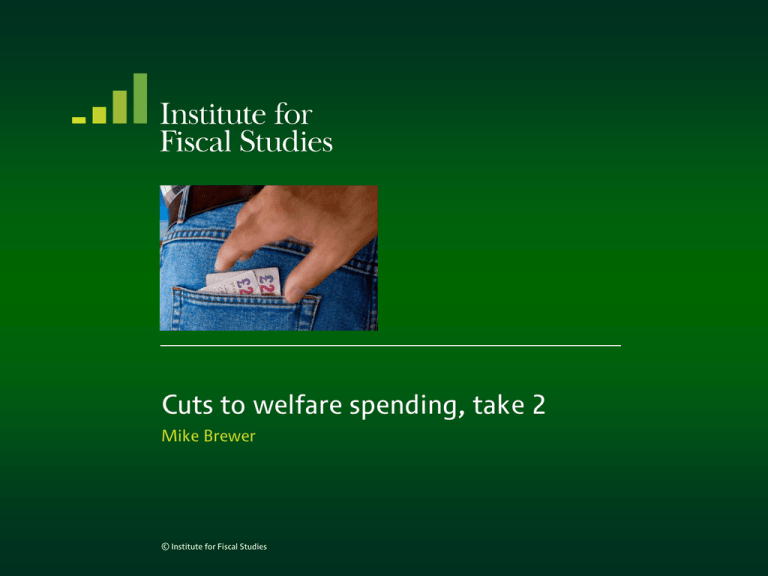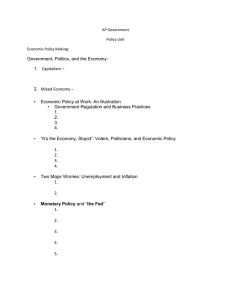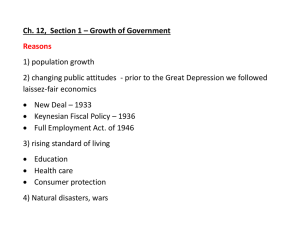Cuts to welfare spending, take 2 Mike Brewer
advertisement

Cuts to welfare spending, take 2 Mike Brewer © Institute for Fiscal Studies Changes to welfare benefits in SR 2010 Saving in 201415 (£bn/yr) Remove Child Benefit from higher-rate taxpayers 2.5 Limit contributory ESA to 12 months unless very disabled 2.0 Various cuts to tax credits 2.1 Cut spending on Council Tax Benefit 0.5 Freeze savings credit part of Pension Credit for 4 years 0.3 Benefit cap of £500/wk (£350/wk if single no kids) 0.3 Cut Local Housing Allowance for single people aged 25-35 0.2 Cut DLA for people in care homes paid for by state 0.1 Total saving (cut) of £7.2bn a year by 2014 © Institute for Fiscal Studies Changes to welfare benefits in SR 2010 Saving in 201415 (£bn/yr) Remove Child Benefit from higher-rate taxpayers 2.5 Limit contributory ESA to 12 months unless very disabled 2.0 Various cuts to tax credits 2.1 Cut spending on Council Tax Benefit (and localise) 0.5 Freeze savings credit part of Pension Credit for 4 years 0.3 Benefit cap of £500/wk (£350/wk if single no kids) 0.3 Cut Local Housing Allowance for single people aged 25-35 0.2 Cut DLA for people in care homes paid for by state 0.1 Increase Child Tax Credit -0.7 Maintain cold weather payments -0.1 Total saving (cut) of £7.2bn a year by 2014 © Institute for Fiscal Studies Child Benefit and Education Maintenance Allowance • Child Benefit to be removed from families with a higher-rate taxpayer from January 2013 – Saves £2.5bn, 1.5m families lose • Not a well-designed means-test – Treats some (arguably) similar families very differently – Some parents will be made worse off by pay rise. HMT think will lose £280m a year through “tax planning” • Child Benefit retained for 16-19s, but EMA to be scrapped – EMAs scrapped as “deadweight was 90%”. But deadweight of child benefit even higher! – Perhaps no need to incentivise young people to stay on if schoolleaving age rising © Institute for Fiscal Studies Employment and Support Allowance • Employment and Support Allowance (ESA), which is replacing Incapacity Benefit, is paid to people judged too ill to work • Recipients need a low income or to have made NI contributions • Contributory ESA will now last only a year unless judged very disabled – Losers (c1 million) will be the less-disabled ESA recipients with high savings or working partners. – Some will get ESA if have sufficiently low income and low assets • Means welfare system will no longer support people who are too ill to work after 12 months if they have their own resources, or a partner who can support them © Institute for Fiscal Studies Tax credits: 4 take-aways, and 1 give-away • Cuts to tax credits of £2.1bn – Freeze Working Tax Credit for 3 years from April 2011 – Cut childcare subsidy in WTC from 80% to 70% from April 2011 – Couples need to work 24, not 16, hours to get WTC from April 2012 – Reduced fraud and overpayments with better earnings data from April 2014 • But spend more on per-child element of Child Tax Credit (up by £30 in 2011 and £50 in 2012 on top of indexation and June Budget changes) • Overall, poorest families with children gain and some working families with children lose © Institute for Fiscal Studies The end of Council Tax Benefit • CTB to be replaced by grants to local authorities in April 2013, who can choose best way of using money to rebate CT bills • But grants lower than current spending on CTB. Saves £0.5bn/yr, but means losses amongst poor households • Attraction is that it devolves power • But many downsides – Goes directly against ideas behind Universal Credit – Creates “postcode lottery” – Local authorities might use CTB to persuade low-income households to live elsewhere – 100+ LAs designing policy – Two levels of government share control over tax and benefit redistribution © Institute for Fiscal Studies Other changes • Freeze maximum savings credit award for 4 years from April 2011 (saves £0.3bn) – A cut in Pension Credit for 1.8m pensioners with small private incomes • Benefit cap of £500/wk (or £350/wk if single no children) if noone in work from April 2013 (saves £0.3bn) – Hits large families and/or families in high-rent areas – Lazy way to make policy. Why not cut, say, Child Tax Credit or Housing Benefit directly? Why not apply it to those in work? • Cut Housing Benefit for single people aged 25-35 from April 2012 (saves £0.2bn) • Cut DLA for people in care homes from April 2012 (saves £0.1bn) • Maintain cold weather payments (costs £0.1bn) • Also: accelerate rise in state pension age © Institute for Fiscal Studies Welfare cuts to date under coalition Government £20,000 £m/yr saving in 2014-15 £17,500 £15,000 £12,500 £10,000 £7,500 £5,000 Not broken down (uprating change) Council Tax Benefit Housing Benefit Disability Living Allowance Employment and Support Allowance Other benefits for families with children Tax credits £2,500 Child benefit £0 -£2,500 © Institute for Fiscal Studies State pension and pension credit Conclusions • £7 billion of welfare cuts, on top of £11bn from June Budget • Most changes focus resources on those who need it most, “so people on low incomes are not subsidising those who are better off” (Osborne’s speech). But – Low-income pensioners have lost some pension credit to fund highincome pensioners’ winter fuel payments – Young people in education with low-income parents have lost their EMAs to fund the continued child benefit of their wealthier peers • Government has refocused benefit spending away from families with children and towards pensioners • In short-run, SR has mixed effects on work incentives. In mediumrun, much depends on Universal Credit... • ...which will now be less effective given the complexity and opacity to come with Council Tax Benefit reform © Institute for Fiscal Studies Cuts to welfare spending, take 2 Mike Brewer © Institute for Fiscal Studies





